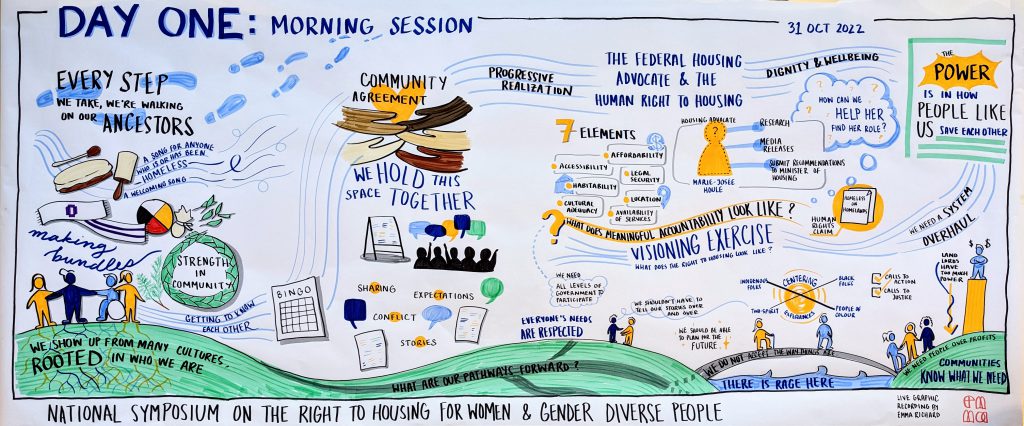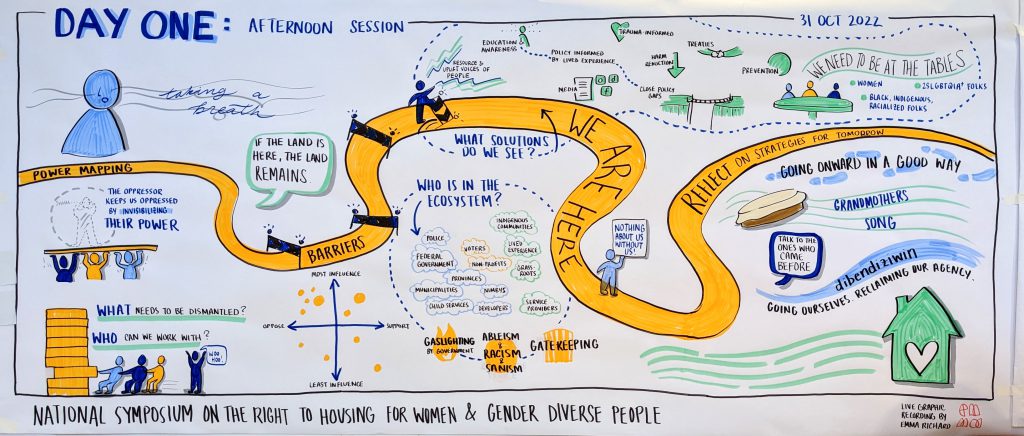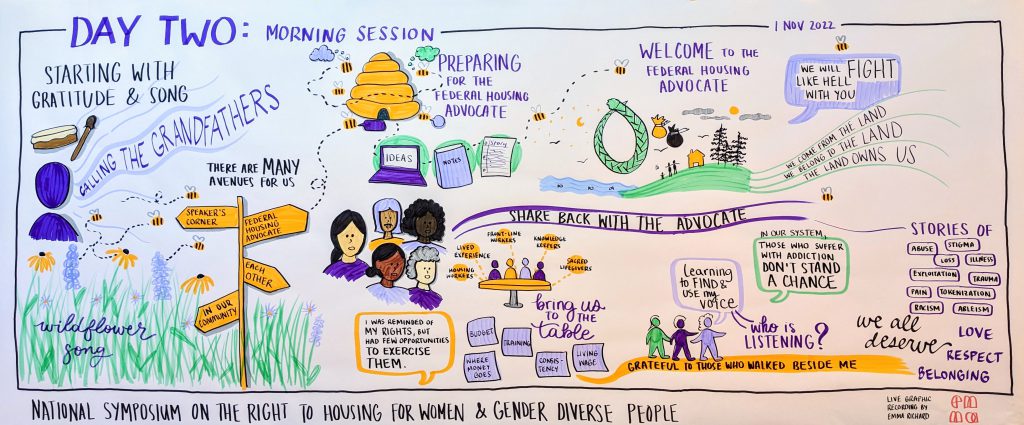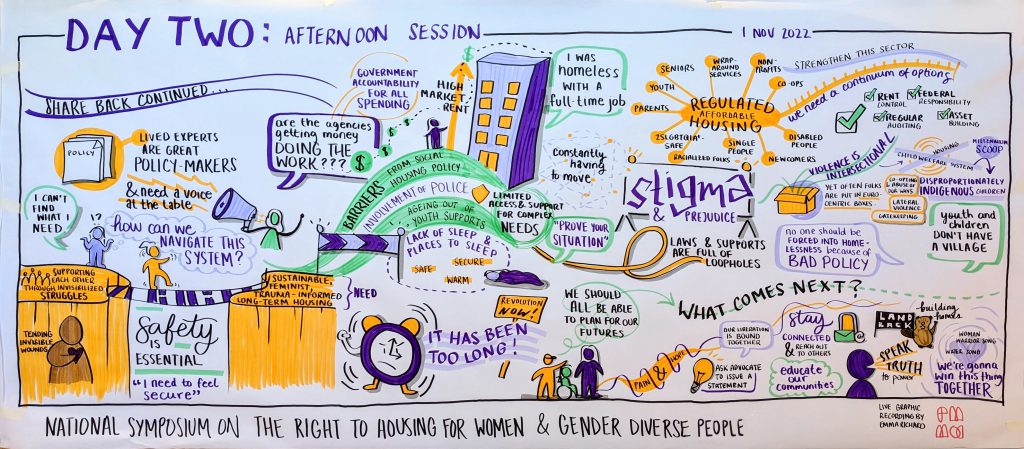Human Rights Practice in Action: Reflections from the National Symposium on the Right to Housing for Women & Gender-Diverse People.
By Kaitlin Schwan & Stefania Seccia, Women’s National Housing & Homelessness Network

Women and gender-diverse people have disproportionately endured the brunt of the housing and homelessness crisis in Canada, but those who suffer most are rarely at decision-making tables or understood as rights-holders. This national human rights crisis has trapped many in situations of abuse and exploitation, separated them from their children, deepened their poverty, dislocated them from their lands and traditions, and eroded their dignity and self-determination.
In the wake of this crisis, The Women’s National Housing & Homelessness Network and the National Indigenous Feminist Housing Working Group came together to co-host the National Symposium on the Right to Housing for Women and Gender-Diverse People in Toronto, Oct. 31- Nov. 1. Building on the two human rights claims we submitted to the Federal Housing Advocate, we wanted to create a platform for lived experts to speak directly to the Federal Housing Advocate and organize a feminist rights-based housing movement. Hosted in partnership with Western University and the National Right to Housing Network, the Symposium hosted over 40 diverse lived experts from across the country, alongside their allies.
Our goal was to build momentum for our movements, learn from each other, and celebrate our successes. Leveraging the recently adopted National Housing Strategy Act (NHSA), our intent was to begin collectively carving a path towards realizing the right to housing for women and gender-diverse people in Canada. We wanted to:
- Develop a vision for what the right to housing means for us and how we can realize it
- Identify violations of the right to housing that uniquely impact women and gender-diverse people
- Share successes and strategies for achieving housing justice
- Collaborate on building community-led solutions that advance our human rights
The results were astounding. We heard from participants that the Symposium was “transformative,” “empowering,” and inspired them to foster rights-based action in their communities. One participant stated:
“The symposium offered a space for people who are marginalized and silenced to speak their truth in a meaningful way.”
But what was so special about the Symposium, and how can we learn from it about rights based practice 
Human Rights Practice in Action
Central to the National Symposium was an intentional and innovative approach to human rights practice, grounded in the principle of meaningful engagement. The focus was on enabling lived experts to concretely engage with human rights accountability mechanisms, collaboratively develop a vision for realizing the right to housing, and exchange knowledge on strategies for surviving the housing crisis. In particular, we wanted to provide opportunities for participants to share their insights and experiences with the Federal Housing Advocate herself – Canada’s first watchdog on the right to housing. Here are a few of the approaches we used that we think were successful:
- Bring the Advocate to Us – The second day of the Symposium we hosted the Federal Housing Advocate in-person at our Symposium. During her visit, participants chose to gather into groups to share key messages, recommendations, and individual testimony about rights violations, with each group determining what and how they would like to share with the Advocate. Lived experts and their allies developed and controlled this process, in a space they had developed themselves and set the terms for. This enabled us to design a human rights process that worked for us.
- Many Ways of Claiming our Rights – We developed a unique process through which Symposium participants could share messages and testimony with the Federal Housing Advocate. In the private “Speakers Corner,” participants could choose to share their message with the Federal Housing Advocate via video, audio, or written testimony. We provided transcribers and videographers – with help from our wonderful friends at Women’s Habitat – to support participants to share what they wanted to, in the way they wanted to, and with the support they needed. We heard from participants that this flexibility fostered safety, accessibility, and most importantly a sense of agency and power over their testimony.
- Community Care and Support – Given the triggers connected to many people’s stories, and how re-telling them can be traumatic, it was critical to have peer support and counselling available to participants. We setup a “relaxation room” where folks could go for a quiet space to process and decompress, speak to a peer support worker or a counsellor, and access traditional medicine (sage, sweetgrass, and tobacco). We also made arrangements for participants to connect with organizers or peer supporters 24/7 during the Symposium, including in the event of distress. This community care helped create the conditions for participants to feel safe during the Symposium, and we heard from many participants that these supports enabled them to share in ways they never had before.
Grounding these practices was the guidance and wisdom of the Indigenous Symposium organizers, who co-designed the Symposium. We were honoured to have Indigenous Knowledge Keepers and drummers open and close each day, facilitate the sharing of testimony with the Advocate, and guide many discussions.

What’s next?
The testimony shared with the Advocate at the National Symposium is foundational to building an evidence-base on the Government of Canada’s failure to adequately address housing need and homelessness for marginalized women and gender-diverse people. This evidence will be considered by the Federal Housing Advocate as part of her review of our human rights claims, and will be built into further legal and human rights efforts undertaken by WNHHN and the NIFHWG.
Most importantly, this is just the beginning of a new movement towards realizing the right to housing for women and gender-diverse people in Canada. We have vibrant visions for what is possible. Join us!


